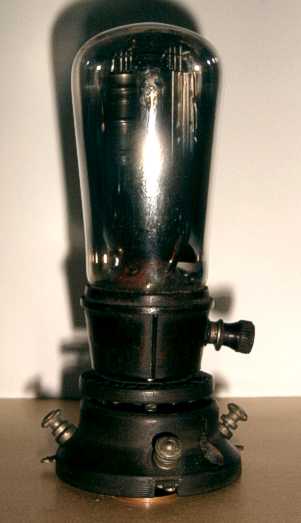 Lissen PT225 pentode. This seems to be quite a rare one. It has a 2V heater and
a 4 pin B4 base.
Lissen PT225 pentode. This seems to be quite a rare one. It has a 2V heater and
a 4 pin B4 base.Operating characteristic:
Heater 2V
Grid 1 -6V
Grid 2 150V
Grid 3 0V
Anode 150V
Anode 8mA
Screen 150V
gm 2.3mA/V
| Museum Menu | Teralab Main Menu | Next Page |
|---|
The valve or vacuum tube is one of the earliest active electronic devices. The simplest form is the diode valve which consists of an anode and a cathode inside an evacuated envelope. The cathode is made from a low work function material and is heated so that electrons are released in a cloud around it. This is known as thermionic emission. A potential difference between anode and cathode accelerates the electrons towards the anode and a current flows. If the potential is reversed, no current flows because electrons are not emitted from the anode. Thus the diode valve can be used as a rectifier. The next most complicated valve is the triode. In the triode there is an additional electrode between anode and cathode, called the grid. A potential on the grid can repel electrons back towards the cathode and thus control the current which flows. This action allows the triode valve to be used as an amplifier.
 Lissen PT225 pentode. This seems to be quite a rare one. It has a 2V heater and
a 4 pin B4 base.
Lissen PT225 pentode. This seems to be quite a rare one. It has a 2V heater and
a 4 pin B4 base.
Operating characteristic:
Heater 2V
Grid 1 -6V
Grid 2 150V
Grid 3 0V
Anode 150V
Anode 8mA
Screen 150V
gm 2.3mA/V
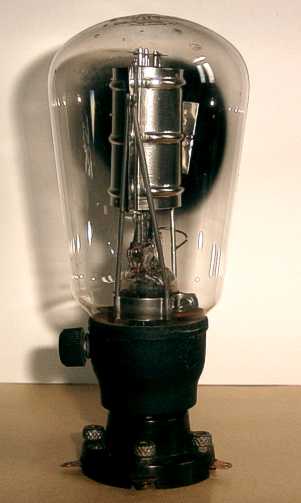 Mazda AC/PEN pentode. It has a B5 5 pin base. The service equivalent is the CV1189.
Mazda AC/PEN pentode. It has a B5 5 pin base. The service equivalent is the CV1189.
Characteristics:
Heater 4V.
Grid 1 -12V
Grid 2 200V
Grid 3 0V
Anode 200V
Anode 24mA
gm 2.5mA/V.
Pin connections:
Pin 1 - Anode
Pin 2 - Heater
Pin 3 - Heater
Pin 4 - Grid 1 (control)
Pin 5 - Grid 2 (screen)
Screw terminal - Cathode and grid 3 (suppressor)
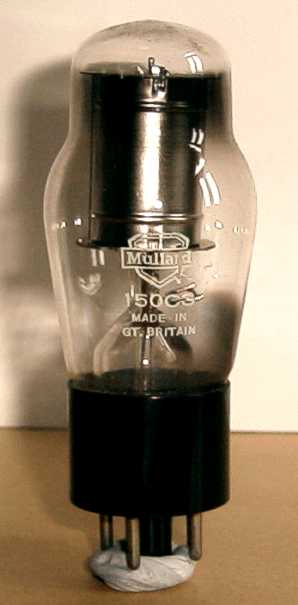 Mullard 150C3 gas filled regulator. The service equivalent is the CV216.
Mullard 150C3 gas filled regulator. The service equivalent is the CV216.
Operating characteristic:
Max striking voltage 180V
Operating voltage 150V
Operating current 5mA to 40mA
Pin connections:
Pin 1 - N/C
Pin 2 - Cathode
Pin 3 - Connected to pin 7
Pin 4 - No pin
Pin 5 - Anode
Pin 6 - No pin
Pin 7 - Connected to pin 3
Pin 8 - N/C
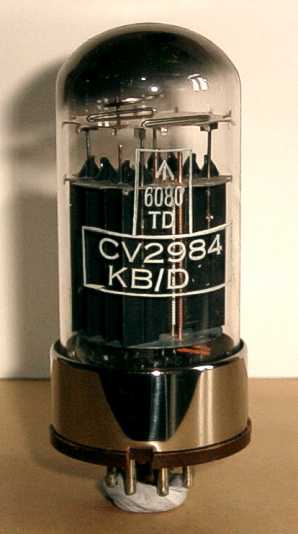 CV2884 double triode. The 6080 is the commercial equivalent. It has an A08 octal
base and is 103mm high. It is intended for use as a series power regulator or in
servo applications.
CV2884 double triode. The 6080 is the commercial equivalent. It has an A08 octal
base and is 103mm high. It is intended for use as a series power regulator or in
servo applications.
Operating characteristic:
Heater 6.3V
Grid -30V
Anode 100V
Anode 100mA
gm 7mA/V
Pin connections:
Pin 1 - Grid 1
Pin 2 - Anode 1
Pin 3 - Cathode 1
Pin 4 - Grid 2
Pin 5 - Anode 2
Pin 6 - Cathode 2
Pin 7 - Heater
Pin 8 - Heater
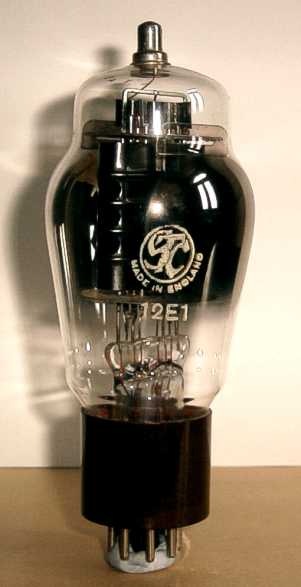 12E1 pentode. The CV345 is the service equivalent. It has an A08 octal base and
an anode cap.
12E1 pentode. The CV345 is the service equivalent. It has an A08 octal base and
an anode cap.
Operating Characteristic:
Heater 6.3V
Grid -20V
Anode 150V
Anode 75mA
Screen 150V
gm 9.6mA/V
Pin connections:
Pin 1 - N/C
Pin 2 - Heater
Pin 3 - N/C
Pin 4 - g2 (screen)
Pin 5 - g1 (control)
Pin 6 - N/C
Pin 7 - Heater
Pin 8 - Cathode
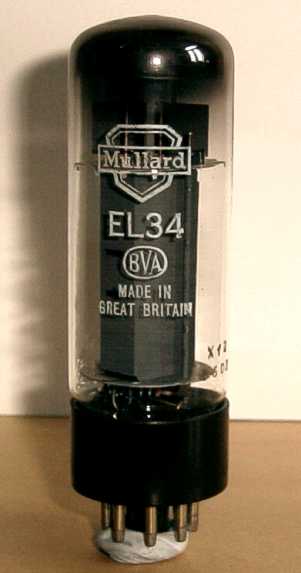 The legendary EL34 pentode. This is one of the few commercial valves which
is still made in large numbers and can be purchased in main stream catalogues.
It is the most popular output valve for hi-fidelity audio amplifiers.
The legendary EL34 pentode. This is one of the few commercial valves which
is still made in large numbers and can be purchased in main stream catalogues.
It is the most popular output valve for hi-fidelity audio amplifiers.
Operating Characteristic:
Heater 6.3V
Grid 1 -12.2V
Grid 2 250V
Grid 3 0V
Anode 250V
Anode 100mA
gm 11mA/V
Pin connections:
Pin 1 - g3 (suppressor)
Pin 2 - Heater
Pin 3 - Anode
Pin 4 - g2 (screen)
Pin 5 - g1 (control)
Pin 6 - N/C
Pin 7 - Heater
Pin 8 - Cathode
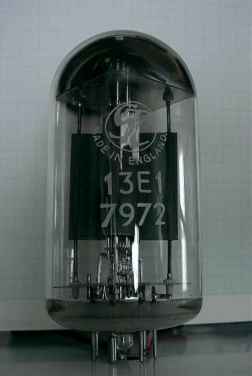 13E1 90W beam tetrode. It has two grids, a control grid and a screen grid.
The screen grid lies between the control grid and the anode. It is kept
at a fixed potential and thus prevents undesirable
positive feedback from anode to control grid. In the beam tetrode,
there are also plates which concentrate the electrons into a beam and
reduce the effects of secondary emission.
13E1 90W beam tetrode. It has two grids, a control grid and a screen grid.
The screen grid lies between the control grid and the anode. It is kept
at a fixed potential and thus prevents undesirable
positive feedback from anode to control grid. In the beam tetrode,
there are also plates which concentrate the electrons into a beam and
reduce the effects of secondary emission.
The beam forming electrodes enclose the screen grid, shielding it
from secondary electrons. The secondary electrons are repelled back
to the anode. There are apertures through the beam forming electrodes
through which the electrons are concentrated. The beam forming electrodes
are really an alternative form of the suppressor grid used in pentodes.
| Museum Menu | Teralab Main Menu | Next Page |
|---|